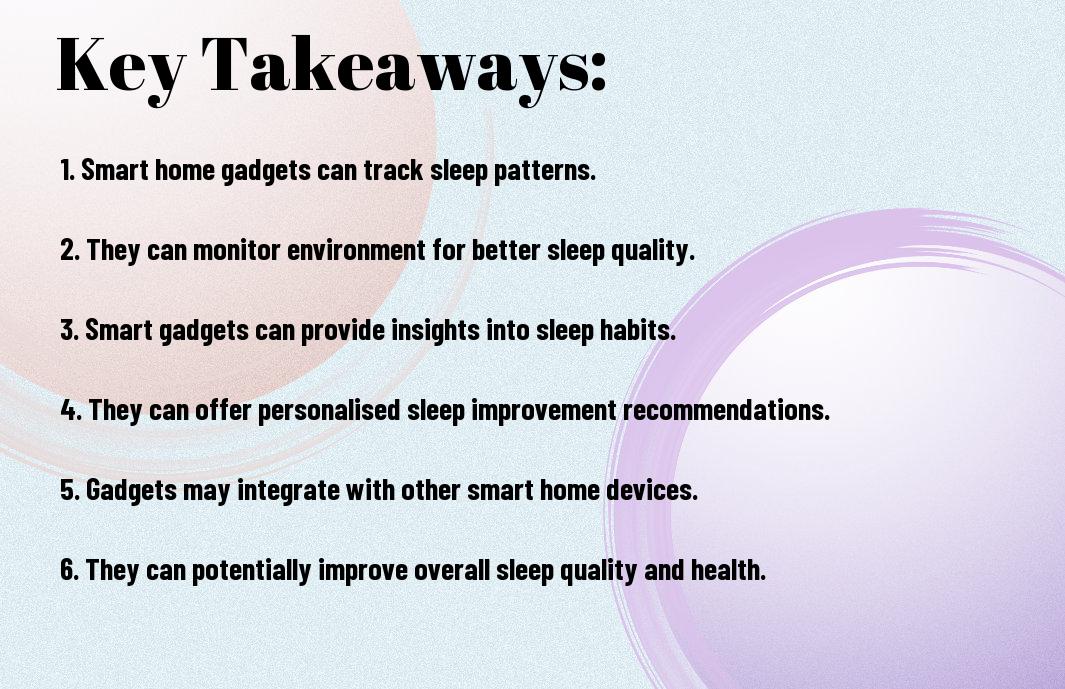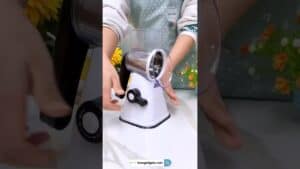Have you ever wondered if your smart home gadgets could actually help you get a better night’s sleep? The answer is yes. With the advancement of technology, there are now a range of smart home devices that can monitor your sleep patterns and provide valuable insights into how to improve your sleep quality. From smart mattresses to smart lights and even smart alarm clocks, there are numerous gadgets that can help you achieve a healthier and more restful sleep. In this blog post, we will explore the benefits and potential risks of using smart home gadgets to monitor and improve your sleep, as well as recommend the most effective devices on the market.
Key Takeaways:
- Smart home gadgets can provide valuable insights into sleep patterns by monitoring factors such as light, noise, and temperature.
- By tracking your sleep quality over time, these gadgets can help you identify patterns and make adjustments to improve your sleep habits.
- Some smart home devices offer tools and features such as white noise machines and automated window coverings to create an optimal sleep environment.
- Integrating smart home technology into your bedtime routine can lead to better sleep hygiene and overall well-being.
- It is important to evaluate the accuracy and reliability of smart home gadgets before relying solely on them for sleep improvement.
Understanding Sleep Monitoring
‘
What is Sleep Monitoring?
Sleep monitoring refers to the process of tracking and analysing your sleep patterns and quality using various smart home gadgets. These gadgets collect data while you sleep, such as your sleep duration, sleep stages, movements, and even environmental factors like temperature and noise levels. By monitoring your sleep, you can gain valuable insights into your sleep habits and make informed decisions to improve your overall sleep quality.
Types of Sleep Data Collected by Gadgets
Smart home gadgets collect a range of sleep data to provide a comprehensive analysis of your sleep patterns. The main types of sleep data collected include sleep duration, sleep stages, sleep disturbances, heart rate, and environmental conditions. After collecting this data, the gadgets use advanced algorithms to process the information and provide you with detailed reports and recommendations to improve your sleep.
- Sleep Duration: The total amount of time you spend sleeping.
- Sleep Stages: The different stages of sleep, including light, deep, and REM sleep.
- Sleep Disturbances: Instances of restlessness, tossing and turning, or frequent awakenings during the night.
- Heart Rate: Your heart rate patterns throughout the night, which can indicate periods of increased stress or arousal.
- Environmental Conditions: Factors such as room temperature, humidity, and noise levels that can impact your sleep quality.
“`html
Popular Smart Home Sleep Gadgets
When it comes to monitoring and improving your sleep quality, there are a range of smart home gadgets on the market that can help. These devices use innovative technology to track your sleep patterns, provide insights, and even make adjustments to your environment to help you get a better night’s sleep.
Smart Mattresses and Pads
If you’re looking to invest in a smart sleep gadget, smart mattresses and pads are a popular choice. These high-tech bedding options often come with built-in sensors that can track your movement, heart rate, and breathing patterns throughout the night. Some models even have the capability to adjust firmness or temperature based on your sleep needs, providing you with personalised comfort and support. This can be especially helpful if you struggle with finding a comfortable sleeping position or have specific requirements for a good night’s sleep.
Wearable Sleep Trackers
Wearable sleep trackers have gained popularity in recent years for their ability to monitor your sleep quality without being intrusive. These devices, often worn as wristbands or clipped onto clothing, use advanced sensors to track your sleep duration, quality, and overall patterns. Some even monitor other health metrics, such as heart rate and movement throughout the day, providing a comprehensive overview of your overall well-being. Having this detailed information can help you make informed decisions about your daily habits and routines that may impact your sleep quality.
Smart Pillows and Bedding
For a more discreet approach to improving your sleep, smart pillows and bedding can also be beneficial. These products are designed with built-in sensors and technology to monitor your sleep patterns without any additional effort required on your part. Some smart pillows even have features such as snore detection and adjustment to keep your head and neck in an optimal position, helping to reduce interruptions to your sleep and potentially improve overall comfort.
Environmental Monitors
Environmental monitors are another category of smart home sleep gadgets that can provide valuable insights into your sleep environment. These devices track factors such as temperature, humidity, and air quality, which can all impact the quality of your sleep. By identifying and addressing any issues with your sleep environment, you can create a more conducive space for restful and rejuvenating sleep.
Sleep Apps and Platforms
Utilising sleep apps and platforms can be a convenient way to monitor and improve your sleep quality, often without the need for additional hardware. Many of these apps offer features such as sleep tracking, personalised sleep recommendations, and guided meditation or relaxation exercises. By integrating these apps into your smart home ecosystem, you can access a wealth of information and resources to support your journey towards better sleep.
“`
Utilizing Data to Improve Sleep
As you delve into the world of smart home gadgets to monitor and improve your sleep, one of the most significant advantages is the ability to utilize data to enhance your sleep quality. These gadgets collect a wealth of information about your sleep patterns, which can be invaluable in making positive changes to your nighttime routine.
Analyzing Sleep Patterns
By using smart home gadgets, you can gain insight into your sleep patterns such as the duration and quality of your sleep, as well as any disturbances throughout the night. This data can help you identify any underlying issues that may be affecting your sleep, enabling you to take targeted action to improve your sleep quality.
Implementing Changes Based on Data
Once you have analysed your sleep patterns, you can then implement changes based on the data collected. Whether it’s adjusting your bedtime routine, investing in a more suitable mattress or addressing any environmental factors, the data can guide you in making informed decisions to optimise your sleep environment.
Integrating Gadgets with Healthy Sleep Habits
Furthermore, these smart home gadgets can be integrated with healthy sleep habits, such as setting reminders for a consistent bedtime or using light and sound features to create a calming pre-sleep atmosphere. By incorporating these gadgets into your routine, you can foster healthier sleep habits and promote better overall sleep quality.
Challenges and Considerations
When considering the use of smart home gadgets to improve your sleep quality, there are several challenges and important considerations to keep in mind. One of the main considerations is the potential privacy and security concerns that come with using these gadgets. Additionally, it’s important to recognise the limitations of technology in addressing sleep issues, as well as how to effectively assess the effectiveness of these gadgets.
Privacy and Security Concerns
As you explore the use of smart home gadgets to monitor and improve your sleep, it’s essential to be aware of the potential privacy and security concerns. Many of these devices collect sensitive data about your sleeping habits, which could be vulnerable to hacking or misuse. It’s crucial to carefully research the security measures in place for any gadget you use and ensure that your data is stored and transmitted securely. To learn more about how technology can help you improve your sleep, you can read more at How Can Technology Help You Improve Your Sleep?
Limitations of Technology
It’s important to recognise that while smart home gadgets can provide valuable insights into your sleep patterns, they also have limitations. These devices may not be able to accurately measure the quality of your sleep or provide tailored solutions for specific sleep issues. Additionally, relying solely on technology to improve your sleep may overlook important lifestyle and behavioural changes that could have a significant impact. It’s essential to approach the use of these gadgets with a balanced perspective and not solely rely on their data and recommendations.
Assessing the Effectiveness of Gadgets
When using smart home gadgets to monitor and improve your sleep, it’s important to assess their effectiveness. It’s crucial to understand how these devices measure sleep quality and whether their recommendations align with your own experiences. Additionally, consider consulting with a healthcare professional to interpret the data accurately and make informed decisions about improving your sleep. Always remember that the use of technology should complement, not replace, professional medical advice.

Can smart home gadgets help you monitor and improve your sleep quality?
With this in mind, it is clear that smart home gadgets can indeed help you monitor and improve your sleep quality. By tracking your sleep patterns, providing ambient lighting to promote better sleep, and even regulating the temperature of your bedroom, these gadgets offer practical solutions to common sleep problems. Additionally, the data collected by these devices can help you identify patterns and make informed decisions about your sleep habits. However, it’s important to remember that these gadgets are tools, and incorporating other healthy sleep habits, such as a consistent bedtime routine and limiting screen time before bed, are also essential for achieving better sleep quality.
Smart Home Gadgets for Monitoring and Improving Sleep Quality FAQ
Q: How can smart home gadgets help in monitoring sleep quality?
A: Smart home gadgets such as sleep trackers and smart watches can monitor your sleep patterns, including duration, quality of sleep, and any disturbances during the night.
Q: What types of smart home gadgets are used for improving sleep quality?
A: Smart home gadgets such as smart lighting, smart thermostats, white noise machines, and smart mattresses are often used to create an environment conducive to better sleep.
Q: Can smart home gadgets help in identifying sleep disorders?
A: Yes, some smart home gadgets have the capability to identify patterns that may indicate sleep disorders such as sleep apnea or insomnia, prompting users to seek medical advice.
Q: What role do smart home gadgets play in improving sleep quality?
A: Smart home gadgets can create a comfortable sleep environment through regulating temperature, reducing ambient noise, and creating soothing lighting, which can all contribute to better sleep quality.
Q: Are smart home gadgets reliable for monitoring sleep quality?
A: While smart home gadgets can provide valuable insights into sleep patterns, their accuracy may vary. It’s important to use them as a helpful tool rather than a definitive diagnosis of sleep quality.
Q: How can smart home gadgets be integrated into a sleep improvement routine?
A: Smart home gadgets can be programmed to create a bedtime routine, adjusting lighting, temperature, and sound to signal the body that it’s time to wind down and prepare for sleep.
Q: What are the privacy and security considerations when using smart home gadgets for sleep monitoring?
A: Users should ensure that their smart home gadgets have strong privacy and security measures in place to protect their sleep data from being accessed by unauthorized parties, and should regularly update their devices’ software.







